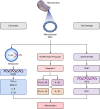Extracellular DNA in blood products and its potential effects on transfusion
- PMID: 32150264
- PMCID: PMC7098128
- DOI: 10.1042/BSR20192770
Extracellular DNA in blood products and its potential effects on transfusion
Abstract
Blood transfusions are sometimes necessary after a high loss of blood due to injury or surgery. Some people need regular transfusions due to medical conditions such as haemophilia or cancer. Studies have suggested that extracellular DNA including mitochondrial DNA present in the extracellular milieu of transfused blood products has biological actions that are capable of activating the innate immune systems and potentially contribute to some adverse reactions in transfusion. From the present work, it becomes increasingly clear that extracellular DNA encompassed mitochondrial DNA is far from being biologically inert in blood products. It has been demonstrated to be present in eligible blood products and thus can be transfused to blood recipients. Although the presence of extracellular DNA in human plasma was initially detected in 1948, some aspects have not been fully elucidated. In this review, we summarize the potential origins, clearance mechanisms, relevant structures, and potential role of extracellular DNA in the innate immune responses and its relationship with individual adverse reactions in transfusion.
Keywords: extracellular DNA; horizontal gene transfer; innate immune response; mtDNA; transfusion; transfusion adverse reaction.
© 2020 The Author(s).
Conflict of interest statement
The authors declare that there are no competing interests associated with the manuscript.
Figures



Similar articles
-
Investigating the impact of mitochondrial DNA: Insights into blood transfusion reactions and mitigation strategies.Vox Sang. 2025 Apr;120(4):354-365. doi: 10.1111/vox.13794. Epub 2025 Jan 8. Vox Sang. 2025. PMID: 39778582 Review.
-
Potential contribution of mitochondrial DNA damage associated molecular patterns in transfusion products to the development of acute respiratory distress syndrome after multiple transfusions.J Trauma Acute Care Surg. 2017 Jun;82(6):1023-1029. doi: 10.1097/TA.0000000000001421. J Trauma Acute Care Surg. 2017. PMID: 28301393 Free PMC article.
-
Platelet-derived extracellular vesicles convey mitochondrial DAMPs in platelet concentrates and their levels are associated with adverse reactions.Transfusion. 2019 Jul;59(7):2403-2414. doi: 10.1111/trf.15300. Epub 2019 Apr 11. Transfusion. 2019. PMID: 30973972
-
Mitochondrial damage-associated molecular patterns as potential proinflammatory mediators in post-platelet transfusion adverse effects.Transfusion. 2016 May;56(5):1201-12. doi: 10.1111/trf.13535. Epub 2016 Feb 26. Transfusion. 2016. PMID: 26920340
-
The epidemiology of multicomponent blood transfusion: a systematic review.Transfus Med. 2019 Apr;29(2):80-94. doi: 10.1111/tme.12584. Epub 2019 Mar 11. Transfus Med. 2019. PMID: 30859667
Cited by
-
CORONIS symposium 2023: Scientific and clinical frontiers in ocular surface innervation.Acta Ophthalmol. 2025 Jun;103(4):e240-e255. doi: 10.1111/aos.17450. Epub 2025 Jan 31. Acta Ophthalmol. 2025. PMID: 39891368 Free PMC article.
-
Association between perioperative plasma transfusion and in-hospital mortality in patients undergoing surgeries without massive transfusion: A nationwide retrospective cohort study.Front Med (Lausanne). 2023 Feb 15;10:1130359. doi: 10.3389/fmed.2023.1130359. eCollection 2023. Front Med (Lausanne). 2023. PMID: 36873874 Free PMC article.
-
New Perspectives on the Importance of Cell-Free DNA Biology.Diagnostics (Basel). 2022 Sep 3;12(9):2147. doi: 10.3390/diagnostics12092147. Diagnostics (Basel). 2022. PMID: 36140548 Free PMC article. Review.
-
Longitudinal profiling in patients undergoing cardiac surgery reveals postoperative changes in DNA methylation.Clin Epigenetics. 2022 Dec 30;14(1):195. doi: 10.1186/s13148-022-01414-4. Clin Epigenetics. 2022. PMID: 36585726 Free PMC article.
-
Extruded small extracellular vesicles: splinters of circulating tumour cells may promote cancer metastasis?Br J Cancer. 2022 Oct;127(7):1180-1183. doi: 10.1038/s41416-022-01934-z. Epub 2022 Aug 23. Br J Cancer. 2022. PMID: 35999274 Free PMC article. Review.
References
-
- Mandel P. and Métais P. (1948) Les acides nucléiques du plasma sanguin chez l'homme. C. R. Seances Soc. Biol. Fil. 142, 241–243 - PubMed
Publication types
MeSH terms
Substances
LinkOut - more resources
Full Text Sources
Medical

